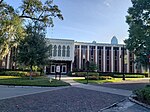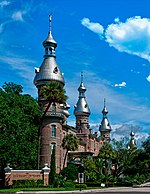Plant Field
Plant Field was the first major athletic venue in Tampa, Florida. It was built in 1899 by Henry B. Plant on the grounds of his Tampa Bay Hotel to host various events and activities for guests, and it consisted of a large field ringed by an oval race track flanked by a large covered grandstand on the western straightaway with portable seating used to accommodate a wide variety of uses. Over the ensuing decades, Plant Field drew Tampa residents and visitors to see horse racing, car racing, baseball games, entertainers, and politicians. The stadium also hosted the first professional football and first spring training games in Tampa and was the long-time home of the Florida State Fair. Al Lopez Field opened in 1954 and Tampa Stadium opened in 1967, and they became the preferred venues for most of the events that had long been held at Plant Field. The aging facility was acquired by the adjacent University of Tampa (UT) in the late 1960s, and in 1971, the name of the grandstand was changed to Pepin-Rood Stadium in honor of university benefactors. After the Florida State Fair moved to a much larger site east of downtown in 1976, Plant Field fell into disuse. Beginning in the 1980s, the University of Tampa began gradually converting Plant Field to other uses. The race track was removed, a series of academic buildings and student housing were built on the periphery of the venue's large footprint, and the last remaining section of the old grandstand was torn down in 2002. However, portions of the original playing field have been incorporated into new venues for the university's athletic programs along with student recreation.
Excerpt from the Wikipedia article Plant Field (License: CC BY-SA 3.0, Authors).Plant Field
West North A Street, Tampa Hyde Park
Geographical coordinates (GPS) Address Nearby Places Show on map
Geographical coordinates (GPS)
| Latitude | Longitude |
|---|---|
| N 27.948524 ° | E -82.4671 ° |
Address
University of Tampa East Campus
West North A Street
33606 Tampa, Hyde Park
Florida, United States
Open on Google Maps






